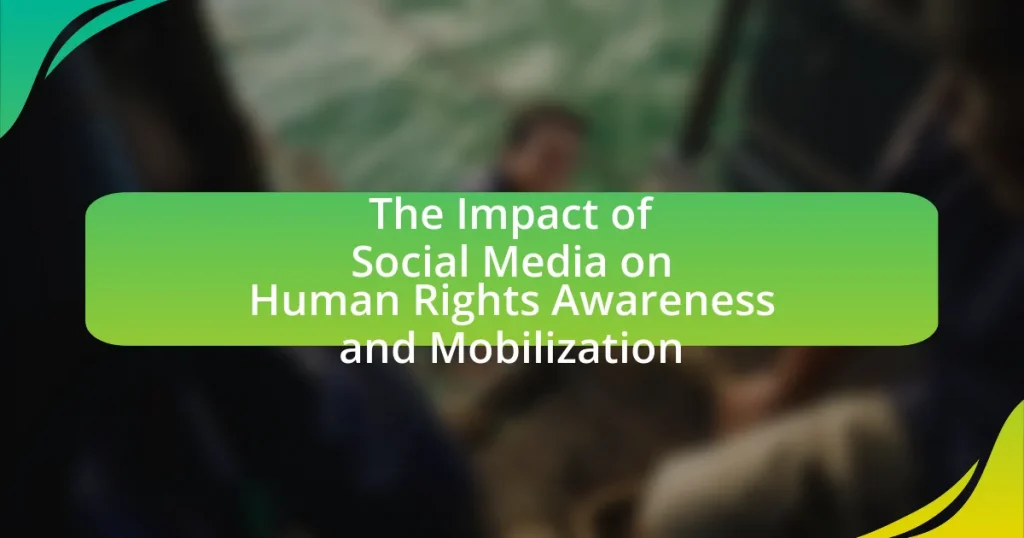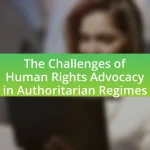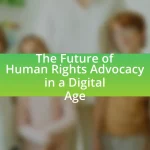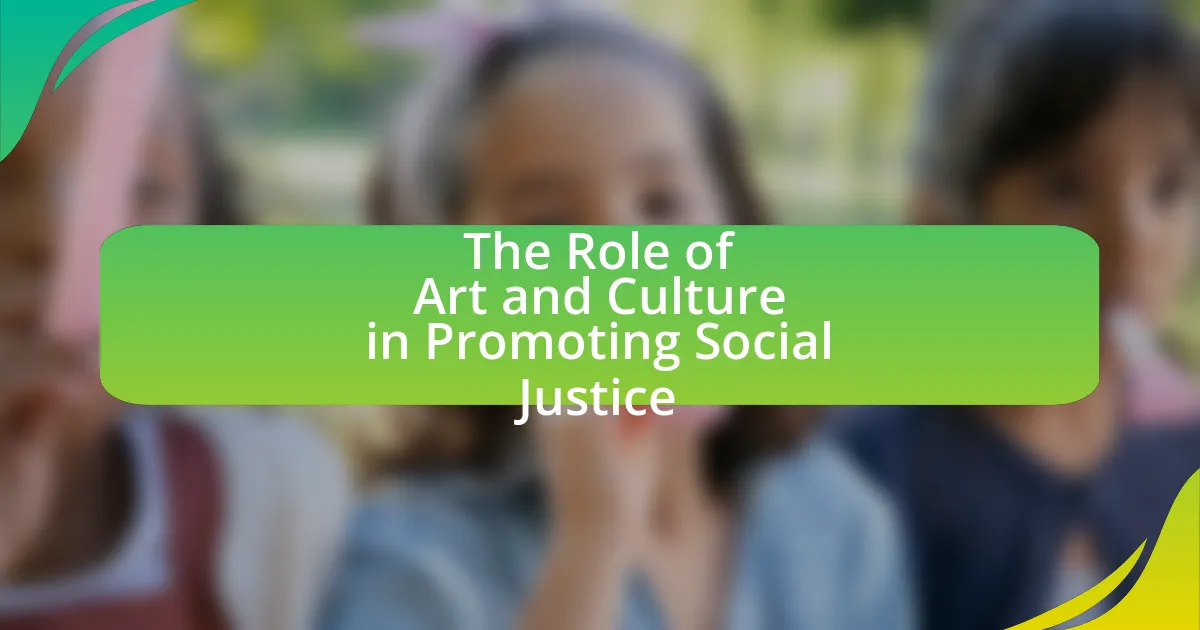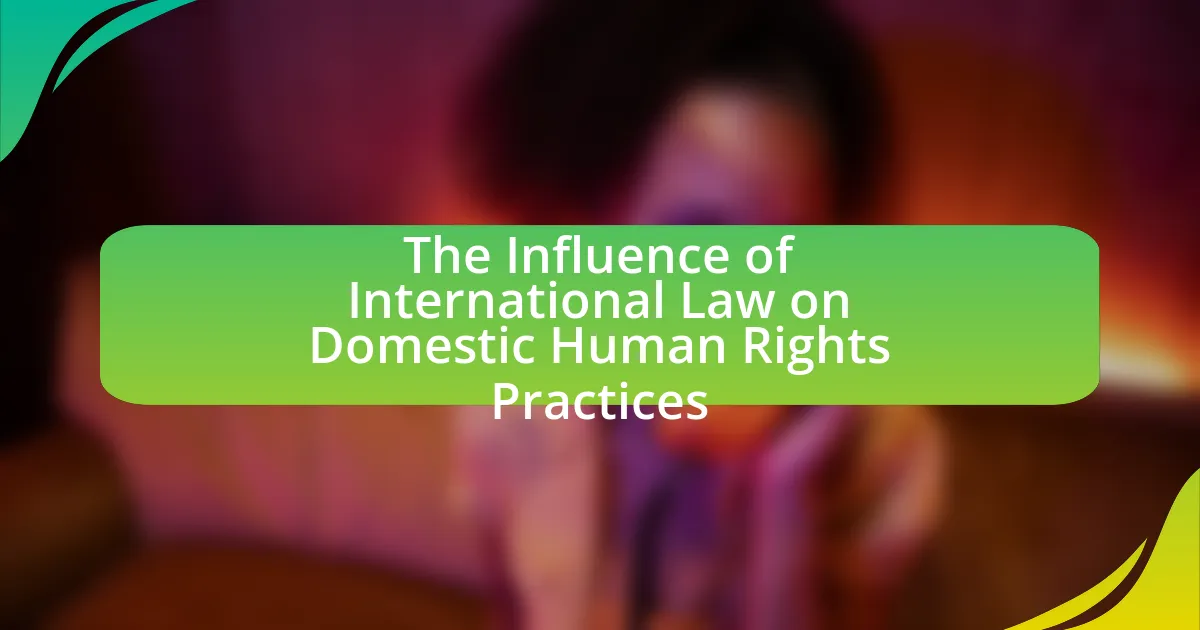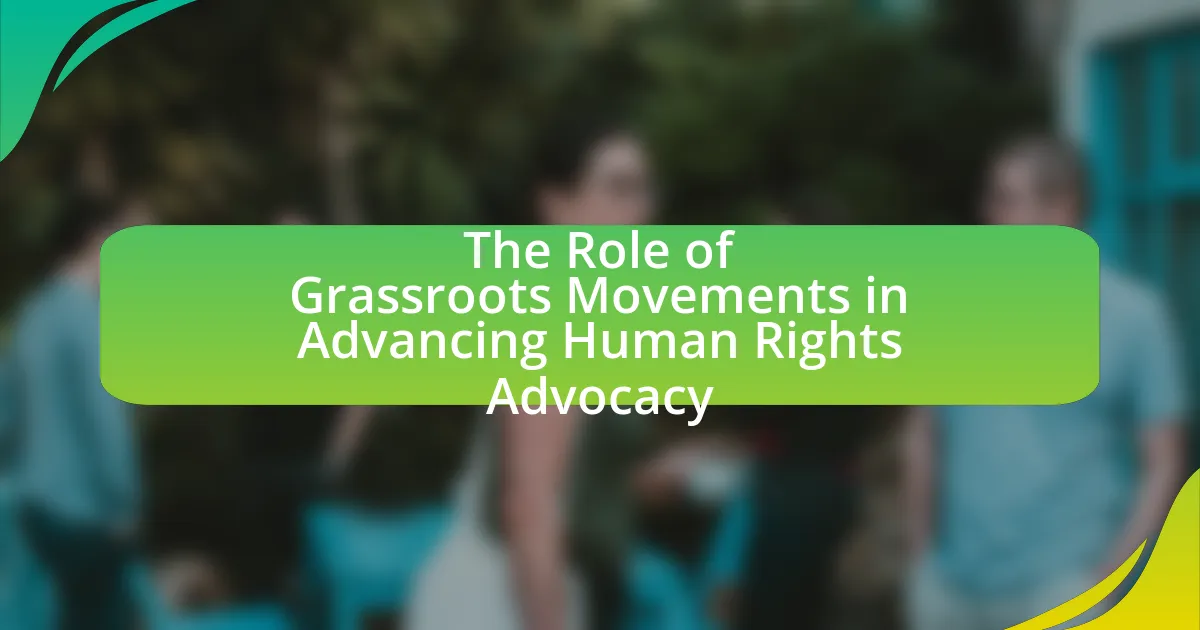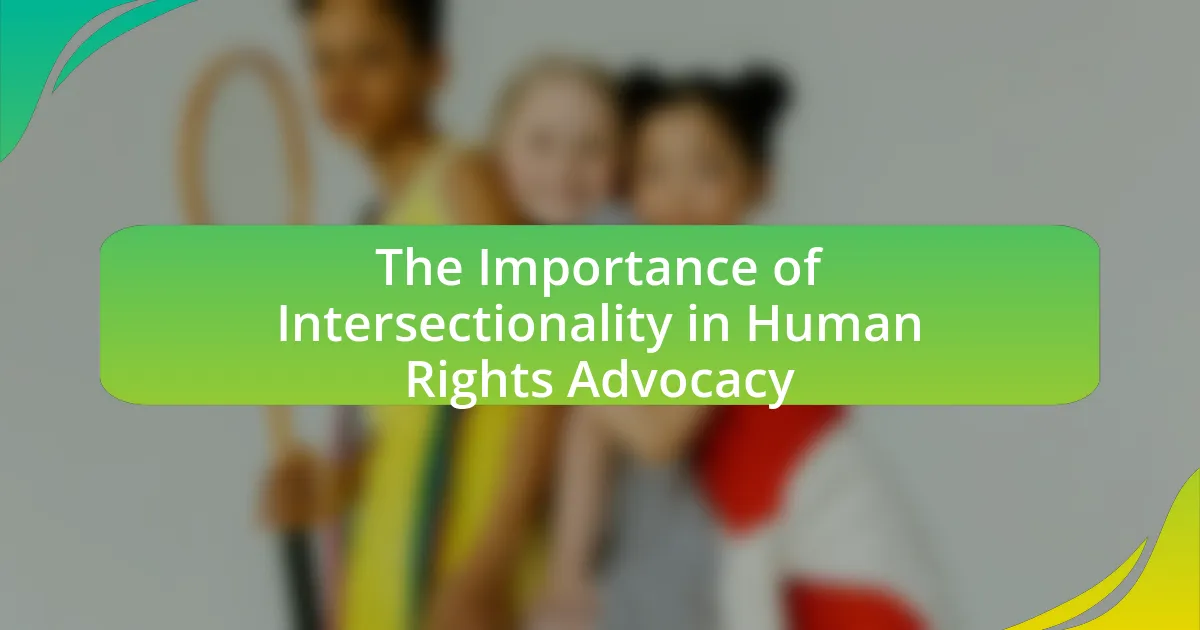The article examines the impact of social media on human rights awareness and mobilization, highlighting its role in disseminating information and fostering community engagement. It discusses how platforms like Twitter and Facebook have transformed human rights advocacy, enabling real-time updates and grassroots mobilization, as evidenced by movements such as #BlackLivesMatter and the Arab Spring. The article also addresses the challenges posed by misinformation, censorship, and the digital divide, while exploring demographic factors that influence social media engagement in human rights issues. Additionally, it outlines future trends in technology and social media that may enhance human rights activism, emphasizing the importance of effective strategies for maximizing impact and countering misinformation.

What is the Impact of Social Media on Human Rights Awareness and Mobilization?
Social media significantly enhances human rights awareness and mobilization by providing a platform for information dissemination and community engagement. It allows individuals and organizations to share human rights violations in real-time, as seen during events like the Arab Spring, where platforms like Twitter and Facebook facilitated rapid communication and organization among activists. According to a study by the Pew Research Center, 64% of social media users have engaged with content related to social issues, indicating a strong correlation between social media use and increased awareness of human rights issues. Furthermore, social media campaigns, such as #BlackLivesMatter, have mobilized millions globally, demonstrating its effectiveness in rallying support and driving social change.
How has social media changed the landscape of human rights advocacy?
Social media has transformed human rights advocacy by providing a platform for rapid information dissemination and grassroots mobilization. This shift allows activists to share real-time updates, organize protests, and raise awareness on a global scale, significantly increasing visibility for human rights issues. For instance, the #BlackLivesMatter movement gained international attention through social media, leading to widespread protests and policy discussions. Additionally, studies show that social media campaigns can lead to increased public engagement and support for human rights initiatives, as evidenced by the 2011 Arab Spring, where platforms like Twitter and Facebook played crucial roles in coordinating protests against oppressive regimes.
What role do social media platforms play in raising awareness about human rights issues?
Social media platforms play a crucial role in raising awareness about human rights issues by providing a space for information dissemination, community engagement, and mobilization. These platforms enable individuals and organizations to share real-time updates, personal stories, and educational content, which can reach a global audience rapidly. For instance, the hashtag #BlackLivesMatter gained significant traction on platforms like Twitter and Instagram, leading to widespread awareness and discussions about racial injustice and police brutality. According to a 2020 study published in the Journal of Human Rights Practice, social media campaigns have been shown to increase public engagement and support for human rights initiatives, demonstrating their effectiveness in influencing social change.
How do social media campaigns influence public perception of human rights?
Social media campaigns significantly influence public perception of human rights by amplifying awareness and facilitating engagement on critical issues. These platforms enable rapid dissemination of information, allowing users to share stories, images, and videos that highlight human rights violations, which can lead to increased public empathy and activism. For instance, the #BlackLivesMatter movement gained global traction through social media, resulting in widespread protests and policy discussions regarding racial injustice. Research indicates that social media can shape public opinion; a study by the Pew Research Center found that 64% of Americans believe social media has a positive impact on political engagement, including human rights advocacy. This demonstrates that social media campaigns not only inform but also mobilize individuals to take action, thereby altering perceptions and driving societal change regarding human rights issues.
Why is social media a powerful tool for mobilization in human rights movements?
Social media is a powerful tool for mobilization in human rights movements because it enables rapid information dissemination and fosters community engagement. Platforms like Twitter and Facebook allow activists to share real-time updates, organize events, and rally support across geographical boundaries. For instance, the Arab Spring demonstrated how social media facilitated mass protests by allowing individuals to coordinate actions and share experiences, leading to significant political changes in multiple countries. Additionally, studies show that social media campaigns can increase awareness and participation; for example, the #BlackLivesMatter movement gained global traction through viral posts that highlighted systemic racism and police brutality, mobilizing millions to participate in protests and discussions.
What are the mechanisms through which social media facilitates mobilization?
Social media facilitates mobilization through mechanisms such as rapid information dissemination, community building, and the amplification of voices. Rapid information dissemination allows users to share news and updates instantly, which can mobilize individuals during crises or social movements, as seen during the Arab Spring when platforms like Twitter and Facebook were pivotal in organizing protests. Community building occurs as social media connects like-minded individuals, fostering solidarity and collective action, exemplified by movements like #MeToo, which united individuals across the globe to address sexual harassment. The amplification of voices enables marginalized groups to reach wider audiences, increasing visibility and support for their causes, as demonstrated by the Black Lives Matter movement, which gained international attention through viral posts and hashtags. These mechanisms collectively enhance the ability of social movements to organize, mobilize, and effect change.
How do hashtags and viral content contribute to human rights activism?
Hashtags and viral content significantly enhance human rights activism by amplifying awareness and mobilizing support for various causes. They create a sense of community and urgency, allowing activists to reach a broader audience quickly. For instance, the hashtag #BlackLivesMatter gained global traction, leading to widespread protests and policy discussions on racial injustice. Research indicates that social media campaigns utilizing hashtags can increase engagement and participation in human rights movements, as seen in the 2011 Arab Spring, where viral content played a crucial role in organizing protests against oppressive regimes. This demonstrates that hashtags and viral content are powerful tools for driving social change and raising awareness about human rights issues.
What challenges does social media present to human rights awareness and mobilization?
Social media presents several challenges to human rights awareness and mobilization, primarily through the spread of misinformation, echo chambers, and censorship. Misinformation can distort facts about human rights issues, leading to public confusion and apathy; for instance, false narratives can undermine legitimate movements, as seen during various protests where misleading information circulated widely. Echo chambers reinforce existing beliefs, limiting exposure to diverse perspectives and hindering constructive dialogue, which can stifle collective action for human rights. Additionally, censorship by governments or platforms can suppress critical voices and limit the reach of human rights advocacy, as evidenced by instances where activists have faced account suspensions or content removals for discussing sensitive topics. These factors collectively impede effective mobilization and awareness efforts in the realm of human rights.
How do misinformation and disinformation affect human rights campaigns on social media?
Misinformation and disinformation significantly undermine human rights campaigns on social media by spreading false narratives that can mislead public perception and erode trust in legitimate advocacy efforts. For instance, false information can create confusion about the goals and methods of human rights organizations, leading to decreased support and engagement from the public. A study by the Pew Research Center found that 64% of Americans believe that misinformation has caused significant confusion about the basic facts of important issues, including human rights. This confusion can result in diminished mobilization efforts, as potential supporters may hesitate to engage with campaigns that they perceive as controversial or misleading. Furthermore, disinformation campaigns can target specific human rights issues, such as racial justice or refugee rights, to incite division and hostility, ultimately hindering progress and advocacy in these areas.
What are the risks of censorship and surveillance for activists using social media?
Censorship and surveillance pose significant risks for activists using social media, primarily by limiting their ability to communicate freely and organize effectively. Censorship can lead to the removal of critical content, silencing dissenting voices and hindering the spread of information essential for mobilization. Surveillance, on the other hand, can result in the monitoring of activists’ activities, leading to potential harassment, arrest, or violence from authorities. For instance, a report by Amnesty International highlights that in countries with high levels of surveillance, such as China and Iran, activists face increased risks of detention and persecution due to their online activities. These risks undermine the fundamental rights to freedom of expression and assembly, crucial for human rights advocacy.
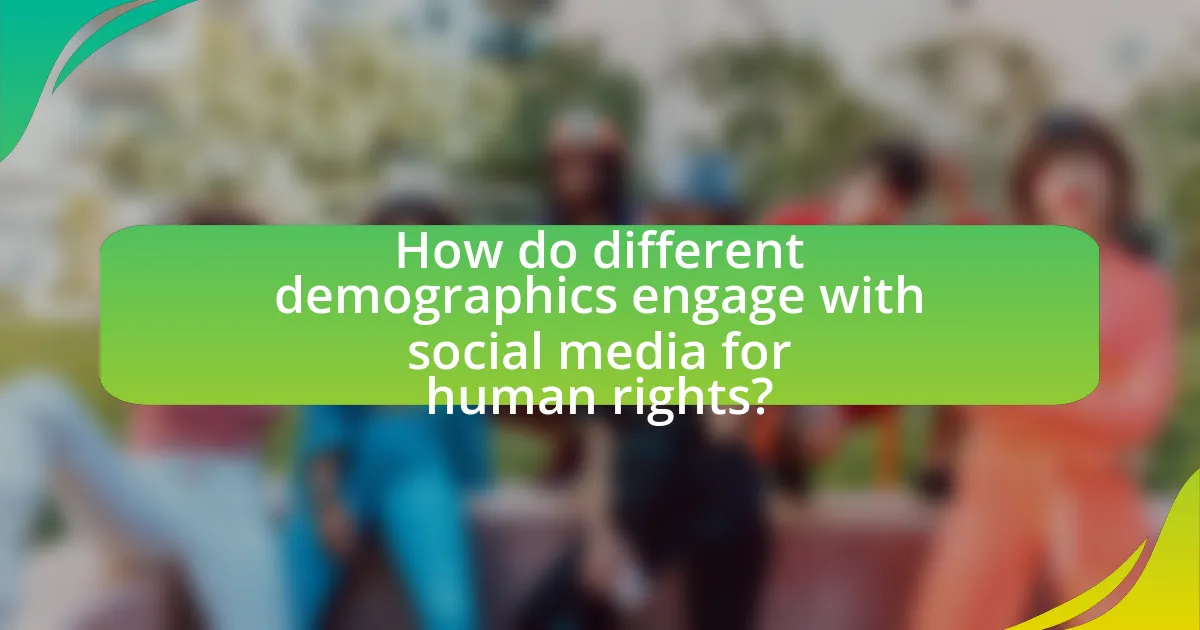
How do different demographics engage with social media for human rights?
Different demographics engage with social media for human rights by utilizing platforms to raise awareness, mobilize support, and share personal experiences related to human rights issues. For instance, younger individuals, particularly those aged 18-29, are more likely to use platforms like Instagram and TikTok to create visually engaging content that highlights social justice movements, as evidenced by a Pew Research Center study indicating that 71% of this age group uses social media for political engagement. In contrast, older demographics, such as those aged 50 and above, tend to favor Facebook for sharing articles and participating in discussions about human rights, reflecting their preference for more traditional forms of content. Additionally, marginalized communities often leverage social media to amplify their voices and connect with broader movements, as seen in the #BlackLivesMatter campaign, which gained significant traction across various demographics, uniting diverse groups in advocacy for racial justice. This multifaceted engagement illustrates how different age groups and communities adapt their social media use to promote human rights effectively.
What demographic factors influence social media usage in human rights advocacy?
Demographic factors that influence social media usage in human rights advocacy include age, gender, education level, and geographic location. Younger individuals, particularly those aged 18 to 29, are more likely to engage with social media platforms for advocacy purposes, as evidenced by a Pew Research Center study indicating that 90% of this age group uses social media. Gender also plays a role, with women often more active in social movements online, as shown in research by the International Journal of Communication, which highlights women’s increased participation in digital activism. Education level impacts usage as well; individuals with higher education are more likely to utilize social media for advocacy, as they tend to have greater access to technology and information. Geographic location influences access to social media and the types of issues prioritized, with urban populations generally having higher engagement levels compared to rural areas.
How do age and education level affect engagement with human rights issues on social media?
Age and education level significantly influence engagement with human rights issues on social media. Younger individuals, particularly those aged 18-29, are more likely to engage with human rights content, as they are generally more active on social media platforms and more inclined to share and discuss social issues. Research from the Pew Research Center indicates that 71% of young adults use social media to express their views on social issues, compared to 47% of those aged 50 and older.
Education level also plays a crucial role; individuals with higher education tend to have greater awareness and understanding of human rights issues, leading to increased engagement. A study published in the Journal of Human Rights Education found that college-educated individuals are more likely to participate in online discussions about human rights, with 60% reporting they frequently engage with such content, compared to only 30% of those with a high school education.
Thus, both age and education level are critical factors that shape how individuals interact with human rights issues on social media, with younger and more educated individuals showing higher levels of engagement.
What role does geographic location play in social media activism for human rights?
Geographic location significantly influences social media activism for human rights by determining access to technology, the political climate, and the cultural context of activism. For instance, in countries with restrictive governments, such as North Korea, social media is heavily censored, limiting activists’ ability to organize and share information. Conversely, in more open societies like the United States, activists can leverage platforms like Twitter and Facebook to mobilize support and raise awareness without fear of immediate repercussions. Additionally, the effectiveness of campaigns often varies based on local issues; for example, the Black Lives Matter movement gained traction in the U.S. due to specific historical and social contexts, while similar movements in other regions may focus on different human rights violations. Thus, geographic location shapes both the opportunities and challenges faced by activists in their efforts to promote human rights through social media.
How do cultural contexts shape the use of social media in human rights movements?
Cultural contexts significantly shape the use of social media in human rights movements by influencing the messaging, engagement strategies, and platform preferences of activists. For instance, in collectivist cultures, social media campaigns often emphasize community solidarity and shared narratives, as seen in movements like Black Lives Matter, which leverage hashtags to unify voices against systemic racism. Conversely, in individualistic cultures, social media may focus on personal stories and individual rights, as demonstrated by the #MeToo movement, which encourages individuals to share their experiences to raise awareness. Additionally, cultural norms dictate the acceptable forms of protest and communication; in some regions, direct criticism of authorities may be met with severe repercussions, leading activists to adopt more coded language or use platforms that offer greater anonymity, such as Telegram. This adaptability reflects the necessity of aligning strategies with local cultural values and societal structures, thereby enhancing the effectiveness of human rights advocacy through social media.
What are the differences in social media strategies across various cultures?
Social media strategies differ significantly across cultures due to varying communication styles, values, and societal norms. For instance, in collectivist cultures like Japan and China, social media strategies often emphasize group harmony and community engagement, leading to content that fosters collective identity and shared experiences. In contrast, individualistic cultures such as the United States prioritize personal expression and self-promotion, resulting in strategies that focus on individual achievements and personal branding.
Additionally, the use of platforms varies; for example, WhatsApp is widely used in Latin America for community organizing, while Facebook remains dominant in many Western countries for broader outreach. Research by the Pew Research Center indicates that cultural context influences how users interact with social media, shaping the types of campaigns that resonate with audiences. Thus, understanding these cultural differences is crucial for effective social media strategies in promoting human rights awareness and mobilization.
How do local issues influence global human rights conversations on social media?
Local issues significantly influence global human rights conversations on social media by providing relatable contexts that resonate with broader audiences. For instance, the Black Lives Matter movement, which originated from local incidents of police violence in the United States, sparked international discussions about systemic racism and police brutality, leading to global protests and policy discussions. This phenomenon illustrates how localized events can catalyze worldwide awareness and mobilization, as social media platforms amplify these narratives, allowing users to share personal experiences and connect them to larger human rights issues. The viral nature of such content often leads to increased engagement and solidarity across borders, demonstrating the interconnectedness of local and global human rights dialogues.
What are the implications of social media engagement for marginalized communities?
Social media engagement significantly empowers marginalized communities by providing a platform for visibility and advocacy. This engagement allows these communities to share their experiences, mobilize support, and raise awareness about social injustices. For instance, movements like #BlackLivesMatter and #MeToo have utilized social media to highlight systemic racism and sexual harassment, respectively, leading to widespread public discourse and policy changes. Research indicates that social media can enhance political participation among marginalized groups, as it facilitates access to information and fosters community solidarity. According to a study by the Pew Research Center, 69% of social media users believe these platforms are important for raising awareness about social issues, demonstrating their role in amplifying marginalized voices.
How does social media empower marginalized voices in human rights discussions?
Social media empowers marginalized voices in human rights discussions by providing a platform for direct communication and visibility. This democratization of information allows individuals from underrepresented communities to share their experiences and perspectives without traditional media gatekeeping. For instance, movements like #BlackLivesMatter and #MeToo gained traction through social media, amplifying the voices of those affected by systemic injustices and harassment. Research indicates that social media can increase awareness and mobilization, with a study by the Pew Research Center showing that 69% of adults in the U.S. believe social media is an effective tool for raising awareness about social issues. This evidence underscores the significant role social media plays in facilitating dialogue and advocacy for marginalized groups in the realm of human rights.
What challenges do marginalized groups face in utilizing social media for advocacy?
Marginalized groups face significant challenges in utilizing social media for advocacy, including digital divide issues, online harassment, and algorithmic bias. The digital divide limits access to technology and the internet, with reports indicating that 25% of low-income households lack broadband access, hindering their ability to engage effectively online. Online harassment disproportionately targets marginalized individuals, with studies showing that 40% of women and LGBTQ+ individuals experience severe online abuse, which can deter them from participating in advocacy. Additionally, algorithmic bias can suppress the visibility of their content, as social media platforms often prioritize mainstream narratives, making it difficult for marginalized voices to gain traction. These challenges collectively undermine the potential of social media as a tool for advocacy among marginalized groups.
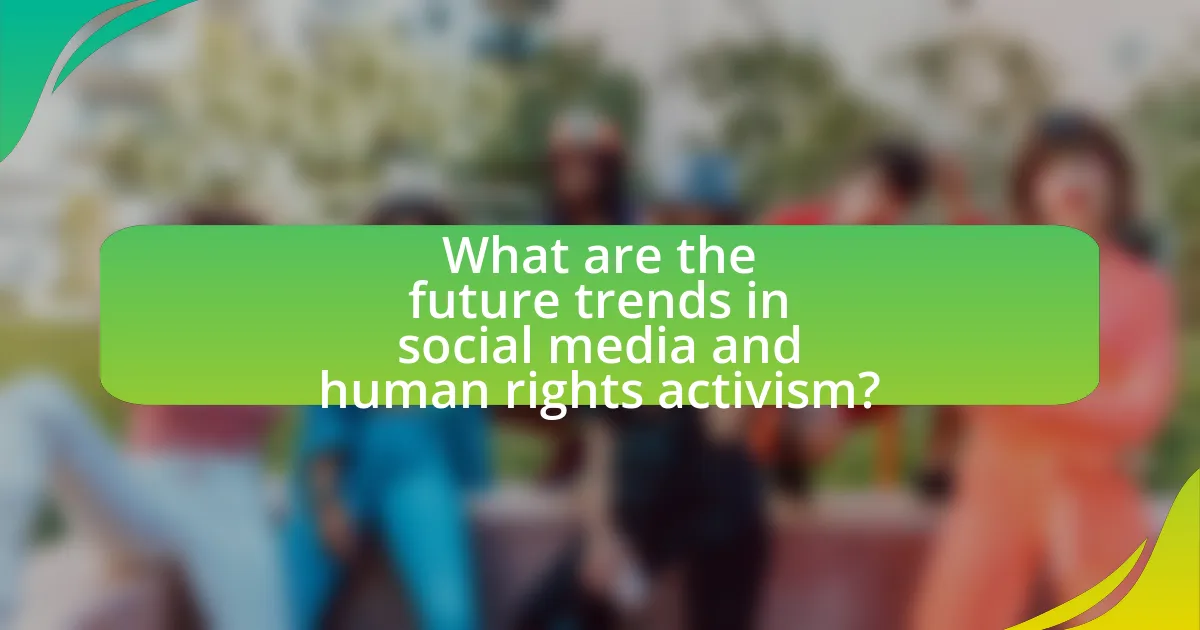
What are the future trends in social media and human rights activism?
Future trends in social media and human rights activism include increased use of artificial intelligence for monitoring human rights abuses, enhanced digital security measures for activists, and the rise of decentralized platforms that prioritize user privacy. These trends are driven by the need for more effective advocacy in response to growing authoritarianism and surveillance. For instance, AI tools are being developed to analyze large datasets from social media to identify patterns of abuse, while platforms like Mastodon offer alternatives to traditional social media that can protect user data. Additionally, the increasing importance of visual storytelling through platforms like TikTok is reshaping how human rights narratives are communicated, making them more accessible and engaging for younger audiences.
How is technology evolving to support human rights advocacy on social media?
Technology is evolving to support human rights advocacy on social media through the development of advanced tools for data collection, analysis, and dissemination. These tools enable activists to monitor human rights violations in real-time, allowing for immediate responses and increased visibility. For instance, platforms like Twitter and Facebook have implemented features that facilitate the reporting of abuses, while machine learning algorithms analyze vast amounts of data to identify patterns of oppression. Additionally, encryption technologies enhance the security of communications for activists, protecting them from surveillance and harassment. According to a report by Amnesty International, the use of social media has led to a 30% increase in public awareness of human rights issues, demonstrating the effectiveness of these technological advancements in mobilizing support and advocacy efforts.
What emerging platforms are gaining traction for human rights mobilization?
Emerging platforms gaining traction for human rights mobilization include TikTok, Clubhouse, and Telegram. TikTok has become a powerful tool for activists to share short, impactful videos that raise awareness about human rights issues, leveraging its vast user base and algorithm to reach diverse audiences. Clubhouse facilitates real-time discussions on human rights topics, allowing activists to engage directly with followers and experts in an audio format. Telegram offers secure communication channels for organizing and mobilizing protests, particularly in regions where traditional social media is restricted. These platforms have demonstrated effectiveness in amplifying voices and fostering community engagement around human rights issues.
How can artificial intelligence enhance the effectiveness of human rights campaigns on social media?
Artificial intelligence can enhance the effectiveness of human rights campaigns on social media by enabling targeted messaging and real-time data analysis. AI algorithms analyze user behavior and preferences, allowing campaigns to tailor their content to specific demographics, increasing engagement rates. For instance, a study by the Pew Research Center found that targeted ads can increase click-through rates by up to 50%. Additionally, AI tools can monitor social media trends and sentiment, providing campaigners with insights into public opinion and enabling them to adjust their strategies accordingly. This data-driven approach leads to more impactful campaigns that resonate with audiences, ultimately driving greater awareness and mobilization for human rights issues.
What strategies can activists adopt to maximize the impact of social media?
Activists can maximize the impact of social media by employing targeted messaging, leveraging visual content, and engaging with their audience consistently. Targeted messaging ensures that activists communicate specific issues clearly, which can resonate more effectively with their audience. For instance, campaigns like #BlackLivesMatter have utilized concise, powerful messages to raise awareness and mobilize support for racial justice.
Leveraging visual content, such as infographics and videos, enhances engagement, as studies show that posts with images receive 94% more views than those without. Engaging consistently with followers through regular updates, responding to comments, and creating interactive content fosters a sense of community and encourages participation. Research indicates that social media interactions can significantly increase the likelihood of offline activism, as seen in the Arab Spring, where social media played a crucial role in organizing protests.
How can activists effectively counter misinformation on social media?
Activists can effectively counter misinformation on social media by employing fact-checking strategies, promoting media literacy, and engaging in proactive communication. Fact-checking involves verifying claims and providing accurate information to debunk false narratives, which is crucial given that 70% of users encounter misinformation on social media platforms. Promoting media literacy equips individuals with the skills to critically evaluate information sources, thereby reducing the spread of false information. Engaging in proactive communication allows activists to create and share compelling narratives that resonate with audiences, making it easier to counteract misleading content. These methods collectively enhance the credibility of activists and foster a more informed public discourse.
What best practices should be followed for successful human rights campaigns on social media?
Successful human rights campaigns on social media should prioritize clear messaging, audience engagement, and strategic partnerships. Clear messaging ensures that the campaign’s goals and values are easily understood, which is crucial for mobilizing support; for instance, campaigns like #BlackLivesMatter effectively used concise slogans to convey their message. Audience engagement involves actively responding to followers and encouraging participation, which fosters a sense of community and commitment; studies show that campaigns with high engagement rates are more likely to succeed in raising awareness and driving action. Strategic partnerships with influencers and organizations can amplify reach and credibility, as seen in campaigns that collaborate with well-known figures to draw attention to human rights issues. These best practices collectively enhance the effectiveness of social media campaigns in promoting human rights awareness and mobilization.
What practical steps can individuals take to support human rights through social media?
Individuals can support human rights through social media by actively sharing credible information, amplifying marginalized voices, and engaging in advocacy campaigns. Sharing credible information helps raise awareness about human rights issues, as studies show that social media can significantly influence public opinion and mobilize support (Pew Research Center, 2021). Amplifying marginalized voices ensures that diverse perspectives are heard, which is crucial for fostering inclusivity and understanding. Engaging in advocacy campaigns, such as signing petitions or participating in online movements, can lead to tangible changes, as evidenced by the success of campaigns like #MeToo and #BlackLivesMatter, which have mobilized millions and influenced policy discussions globally.
